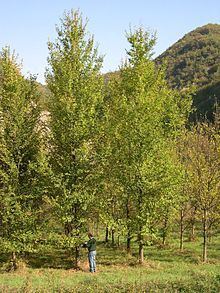Cultivar 'Fiorente' | ||
 | ||
Hybrid parentage U. pumila S.10 × U. minor C. 02 Similar Ulmus 'Plinio', Ulmus minor 'Propendens', Ulmus 'Recerta', Ulmus minor 'Purpurascens', Ulmus 'Arno' | ||
Ulmus 'Fiorente' is a hybrid cultivar elm derived from a crossing of the Siberian Elm Ulmus pumila clone 'S.10' (female parent) from Lucca, Italy, with the Ulmus minor clone 'C.02' from Lungarno, Florence by the Istituto per la Protezione delle Piante (IPP), part of the Italian National Research Council, in Florence. 'Fiorente' was patented in 2006, and released to commerce in 2012.
Contents
'Fiorente' was introduced to the UK in 2007 by Hampshire & Isle of Wight Branch, Butterfly Conservation as part of its assessment of DED-resistant cultivars as potential hosts of the endangered White-letter Hairstreak.
Description
'Fiorente' is usually monopodial, and capable of exceptionally rapid development; during trials in the Northern Apennine on poor clay soils, growth exceeded 1.0 m in height and 1.5 cm in trunk d.b.h per annum. The tree's habit is conical, with a pronounced apical dominance; lateral growth is limited, the crown therefore rather columnar. The alternate leaves are of moderate size, < 8 cm long × < 5 cm broad; generally lanceolate in shape, they are rough on the upper surface and pubescent beneath, remaining green well into the autumn and shed relatively late. The tree usually commences flowering in its fourth or fifth year, during late February in Italy. The sessile samarae are ovate, < 14 × 17 mm.
Pests and diseases
Tested by inoculation with unnaturally high concentrations of the fungal pathogen, 'Fiorente' revealed a good resistance to Dutch Elm Disease, sustaining 32% defoliation and 20% dieback; not as resistant as Lutèce (20% defoliation and 12% dieback), but significantly better than the older Dutch cultivars such as 'Lobel' (50% and 35.5% resp.) released in the early 1970s. 'Fiorente' is resistant to Elm Yellows, while susceptibility to the elm leaf beetle Xanthogaleruca luteola is much the same as that of the Field Elm Ulmus minor.
Cultivation
In Italy, the cultivar's rapid growth has bestowed it economic potential as a hardwood timber and biomass tree. Introduced to southern England in 2007 by Butterfly Conservation, the tree is not known to have been introduced to North America or Australasia. 'Fiorente' has proven intolerant of ponding on lowland sites overwinter, while its growth rates elsewhere on clay and chalk have initially been moderate, in contrast to its compatriots 'San Zanobi' and 'Plinio'.
Etymology
'Fiorente' translates as 'flourishing'.
